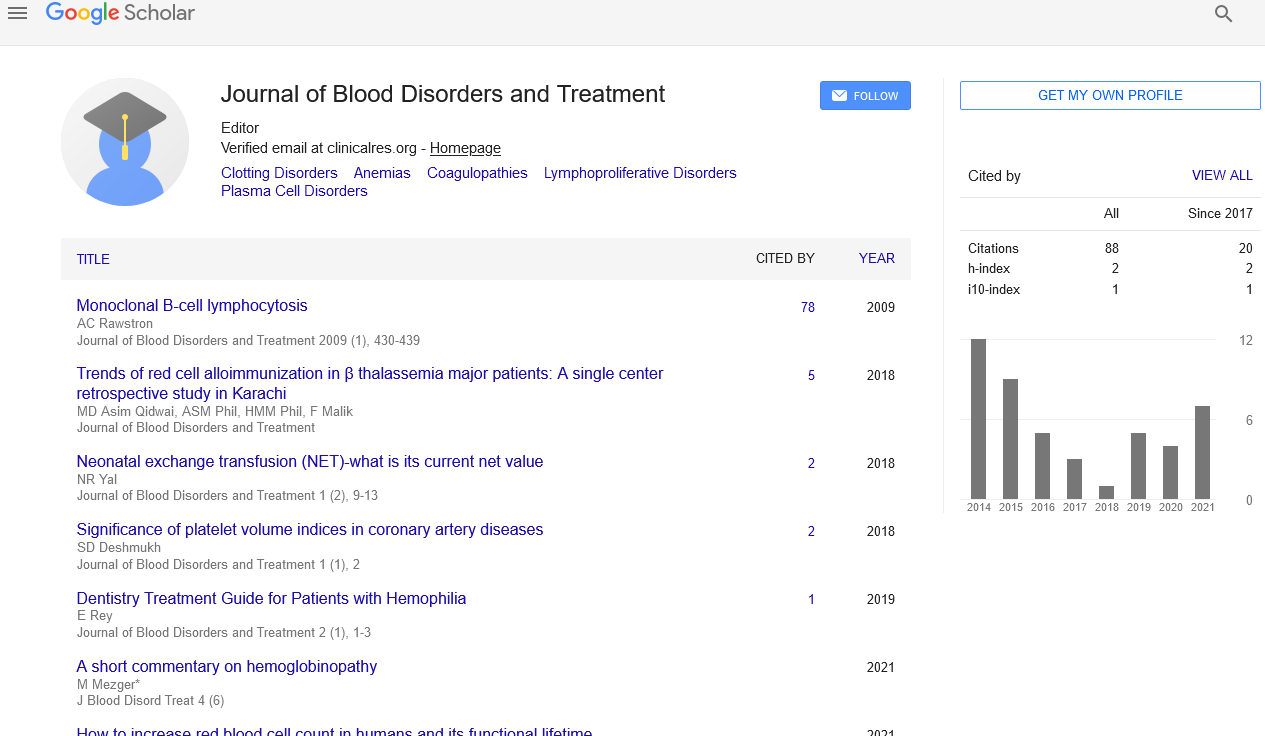A short commentary on hemoglobinopathy
Received: 03-Nov-2021 Accepted Date: Nov 16, 2021; Published: 23-Nov-2021
Citation: Mezger M. A short commentary on hemoglobinopathy. J Blood Disord Treat. 2021;4(6):17.
This open-access article is distributed under the terms of the Creative Commons Attribution Non-Commercial License (CC BY-NC) (http://creativecommons.org/licenses/by-nc/4.0/), which permits reuse, distribution and reproduction of the article, provided that the original work is properly cited and the reuse is restricted to noncommercial purposes. For commercial reuse, contact reprints@pulsus.com
Abstract
Hemoglobinopathy is the clinical term for a gathering of acquired blood issues and sicknesses that fundamentally influence red platelets. They are single-quality issues and, by and large, they are acquired as autosomal co-predominant attributes. There are two primary gatherings: strange underlying hemoglobin variations brought about by transformations in the hemoglobin qualities, and the thalassemias, which are brought about by an underproduction of in any case ordinary hemoglobin atoms.
Keywords
Hemoglobinopathy, Thalassemia, Heinz bodies
Introduction
Hemoglobinopathy is the clinical term for a gathering of acquired blood issues and sicknesses that fundamentally influence red platelets. They are single-quality issues and, by and large, they are acquired as autosomal co-predominant attributes. There are two primary gatherings: strange underlying hemoglobin variations brought about by transformations in the hemoglobin qualities, and the thalassemias, which are brought about by an underproduction of in any case ordinary hemoglobin atoms. The super underlying hemoglobin variations are HbS, HbE and HbC. The fundamental sorts of thalassemia are alpha-thalassemia and beta thalassemia. The two conditions might cover since certain conditions which cause irregularities in hemoglobin proteins likewise influence their creation. Some hemoglobin variations don’t cause pathology or pallor, and accordingly are regularly not classed as hemoglobinopathies [1].
Typical human hemoglobins are tetrameric proteins made out of two sets of globin chains, every one of which contains one alpha-like (α-like) chain and one beta-like (β-like) chain. Every globin chain is related with an ironcontaining heme moiety. All through life, the amalgamation of the alpha-like and the beta-like (additionally called non-alpha-like) chains is adjusted so their proportion is somewhat consistent and there is no overabundance of either typeFetal (Hb F) is delivered from roughly two months of incubation through birth and comprises around 80% of Hb in the full-term youngster. It decreases during the initial not many long periods of life and, in the ordinary state, establishes <1 percent of absolute Hb by youth. Hb F is made out of two alpha globins and two gamma globins (α2γ2). Grown-up (Hb A) is the transcendent Hb in youngsters by a half year old enough and forward; it establishes 96-97% of complete Hb in people without a hemoglobinopathy. It is made out of two alpha globins and two beta globins (α2β2). Hb A2 is a minor grown-up Hb that typically represents around 2.5-3.5% of absolute Hb from a half year old enough ahead. It is made out of two alpha globins and two delta globins [2].
Hb variations: Hb underlying variations are subjective imperfections that cause an adjustment of the design (essential, optional, tertiary, or potentially quaternary) of the Hb atom. Most of Hb variations don’t cause illness and are most normally found either unexpectedly or through infant screening. A subset of Hb variations can cause serious illness when acquired in the homozygous or compound heterozygous state in blend with another primary variation or a thalassemia change. At the point when clinical results happen, they might incorporate frailty because of hemolysis or polycythemia because of changes in the oxygen liking of the strange Hb. Normal instances of hemoglobin variations related with hemolysis incorporate sickle (Hb S) and Hb C. Hb variations can for the most part be identified by protein-based test techniques; be that as it may, DNA-based strategies might be needed for variations with uncertain or strange outcomes from protein examination [3]. The major utilitarian results of Hb underlying variations can be named follows:
•Change in actual properties (dissolvability): Common beta globin changes can modify the solvency of the Hb particle: Hb S polymerizes when deoxygenated and Hb C solidifies.
•Reduced protein soundness (precariousness): Unstable Hb variations are changes that influence the Hb atom to accelerate, precipitously or upon oxidative pressure, bringing about hemolytic weakness. Accelerated, denatured Hb can connect to the inward layer of the plasma film of the red platelet (RBC) and structure Heinz bodies.
•Change in oxygen liking: High or low oxygen liking Hb atoms are almost certain than typical to embrace the casual (R, oxy) state or the strained (T, deoxy) state, separately. High oxygen liking variations (R state) cause polycythemia (e.g., Hb Chesapeake, Hb Montefiore). Low oxygen partiality variations can cause cyanosis (e.g., Hb Kansas, Hb Beth Israel).
•Oxidation of heme iron: Mutations of the heme restricting site, especially those influencing the preserved proximal or distal histidine buildups, can create M-hemoglobin, in which the iron molecule in heme is oxidized from the ferrous (Fe2+) state to the ferric (Fe3+) state, with resultant methemoglobinemia [4].
A few hemoglobinopathies (and furthermore related infections like glucose-6-phosphate dehydrogenase insufficiency) appear to have given a transformative advantage, particularly to heterozygotes, in regions where jungle fever is endemic. Jungle fever parasites live inside red platelets, however unobtrusively upset typical cell work. In patients inclined for quick freedom of red platelets, this might prompt early annihilation of cells contaminated with the parasite and expanded possibility of endurance for the transporter of the attribute.
REFERENCES
- Eaton, William A, Hofrichter. Sickle Cell Hemoglobin Polymerization. Advances in Protein Chemistry. 1990;40:63-279.
- Srivastava P, Kaeda J, Roper D, et al. Severe hemolytic anemia associated with the homozygous state for an unstable hemoglobin variant (Hb Bushwick). Blood. 1995;86(5):1977-82.
- Percy MJ, Butt NN, Crotty GM, et al. Identification of high oxygen affinity hemoglobin variants in the investigation of patients with erythrocytosis. Haematologica. 2009;94(9):1321-2.
- Wilcox I, Boettger K, Greene L, et al. Hemoglobin Kenya composed of alpha- and ((A)gammabeta)-fusion-globin chains, associated with hereditary persistence of fetal hemoglobin. Am J Hemato. 2009;84(1):558.





